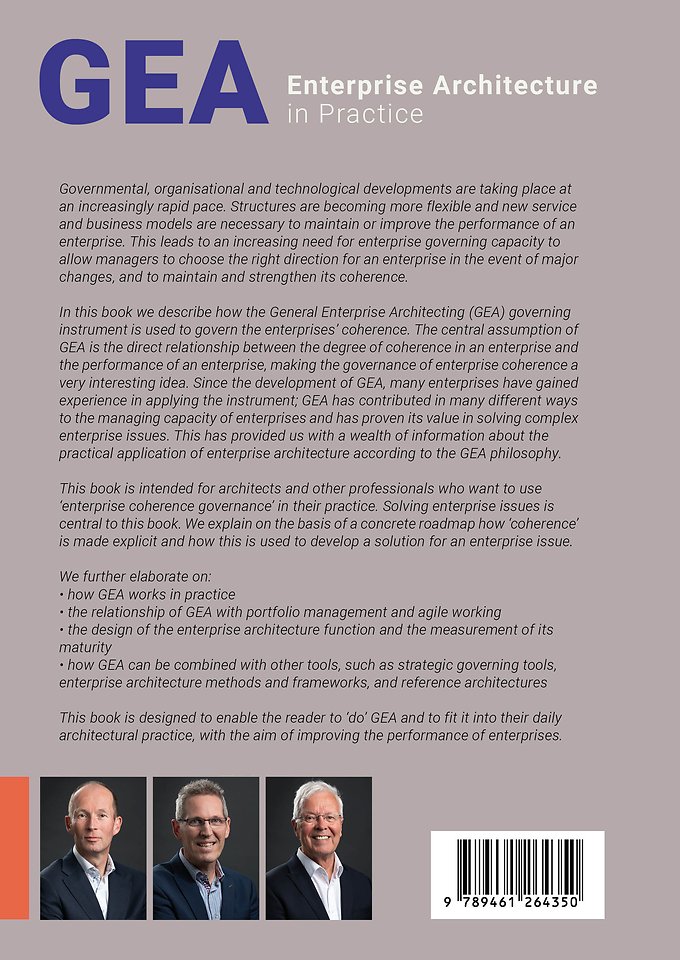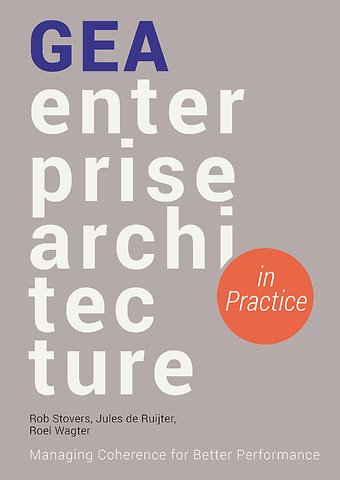



Rob Stovers is an experienced enterprise architect at Solventa and lecturer at the Solventa Academy.
Meer over de auteursGEA Enterprise Architecture in Practice
Managing Coherence for Better Performance
Paperback Engels 2020 1e druk 9789461264350Samenvatting
Governable, organizational and technological developments are taking place at an increasingly rapid pace. Structures are less and less fixed and new service and business models are necessary to maintain or improve the performance of an organization. This leads to an increasing need for governing capacity to quickly choose the right direction as an organization in the event of major changes and to maintain and strengthen coherence.
This book shows how the General Enterprise Architecting (GEA) governing instrument is used to govern the enterprises' coherence. Since the development of GEA, many organizations have gained experience in applying the instrument. In many different ways, GEA has contributed to the managing capacity of organizations and the solution of complex issues. This provided a wealth of information about the practical application of enterprise architecture according to the GEA philosophy.
This book is intended for (enterprise) architects and other professionals who want to use 'enterprise coherence governance' in their practice. Solving enterprise issues is central to this book. On the basis of a concrete roadmap, it is explained how 'coherence' is made explicit and how this is used to develop a solution for an enterprise issue.
From this basis, this book further elaborates on:
• how GEA works in practice
• the relationship with portfolio management and agile working
• the design of the enterprise architecture function and the measurement of its maturity
• how GEA can be combined with other tools, such as strategic governing tools, enterprise architecture methods and frameworks, and reference architectures.
This book enables the reader to 'do' GEA and to fit it into daily architectural practice. With the aim of improving the performance of organizations.
Specificaties
Lezersrecensies
Over Jules de Ruijter
Over Roel Wagter
Inhoudsopgave
U kunt van deze inhoudsopgave een PDF downloaden
List of commonly used terms
1. SOLVING ENTERPRISE ISSUES WITH GEA
1.1 Enterprise architecture
1.1.1 What is enterprise architecture?
1.1.2 The added value of enterprise architecture
1.1.3 Enterprise architecture methods and frameworks
1.1.4 The position of GEA
1.2 Enterprise coherence governance
1.2.1 What is coherence and its importance?
1.2.2 Characteristics of enterprise coherence governance according to GEA
1.3 Making coherence explicit: the GEA Framework
1.3.1 Elements and coherence at level of purpose
1.3.2 Elements and coherence at design level
1.3.3 Coherence between level of purpose and level of design
1.4 Enterprise Issues
1.4.1 The concept of enterprise and its definition
1.4.2 Types of enterprise issues
1.4.3 Trends in enterprise issues
1.5 Roadmap to solve an enterprise issue
1.5.1 Step 1: Initiating
1.5.2 Step 2: Analyzing coherence
1.5.3 Stap 3: Analyzing issue
1.5.4 Step 4: Developing integral solution contour
1.5.5 Step 5: Creating realization plan solution contour
1.5.6 Step 6: Including developments in portfolio
1.6 Connection with the realization
1.6.1 GEA and portfolio management
1.6.2 GEA and agile working
1.7 Advanced applications of GEA
1.7.1 Multiple governance levels
1.7.2 A group with divisions
1.7.3 Alliances
1.7.4 Chains and networks
1.7.5 Mergers and Acquisitions
2. GEA IN PRACTICE
2.1 GEA-cases
2.1.1 De Key housing foundation
2.1.2 Other applications of GEA
2.1.3 Assignment practical case
2.2 Work method
2.2.1 The added value of co-creation
2.2.2 Stakeholders and their role
3. SETTING UP THE ENTERPRISE ARCHITECTURE FUNCTION
3.1 Permanently enterprise coherence governance
3.2 The enterprise architecture vision
3.2.1 GEA's basic philosophy: coherence
3.2.2 The requirements that enterprise architecture must meet
3.2.3 The definition of enterprise coherence governance
3.2.4 The description of the coherent elements
3.3 The enterprise architecture processes and products
3.3.1 The influence of the GEA vision on the GEA processes and products
3.3.2 Positioning of the GEA processes and products
3.3.3 The governance processes to be supported by GEA
3.3.4 GEA processes en products
3.3.5 Setting up GEA processes in the own organization
3.4 The enterprise architecture people
3.4.1 Approach and structure of the GEA competence profile
3.4.2 The GEA competence profile
3.4.3 Some conclusions and recommendations
3.5 The enterprise architecture means
3.5.1 Budget and means
3.5.2 GEA meta-models
3.5.3 GEA training
3.5.4 GEA certification
3.6 The enterprise architecture governance
3.6.1 The role of the enterprise architecture function
3.6.2 GEA-governance
3.7 The enterprise architecture method
4. MEASURING ENTERPRISE COHERENCE GOVERNANCE
4.1 The design of the GEA assessment
4.2 The GEA assessment process
4.3 The GEA assessment products
4.3.1 Spider diagram
4.3.2 Quadrant diagram
4.4 Results of the application of the GEA assessment
4.4.1 GEA assessment 2011
5. GEA AND OTHER INSTRUMENTS
5.1 GEA and other strategic steering instruments
5.1.1 Strategic steering instruments
5.1.2 Essence and scope of BSC, 7-S and INK
5.1.3 Steering instruments compared
5.1.4 GEA and Balanced Scorecard
5.1.5 GEA and 7S model
5.1.6 GEA and INK
5.2 GEA and enterprise architecture methods
5.2.1 TOGAF
5.2.2 DYA
5.2.3 Business Transformation Framework (BTF) / Novius Architecture Method
5.3 GEA and enterprise architecture frameworks
5.3.1 Solventa framework for architecture & transformations
5.3.2 The Zachman Framework (tm)
5.4 GEA and Reference Architectures
5.4.1 Explanation NORA
5.4.2 GEA and NORA
5.4.3 Integrating NORA principles and organization specific principles
5.4.4 Case: bundling of services
Attachments
Appendix A: Perspectives practical case
Appendix B: Principles explained in more detail
Appendix C: Maturity Matrix GEA assessment
Appendix D: Rating questions GEA assessment
Appendix E: Open questions GEA assessment
Appendix F: EA Success Factors and EA Requirements
Appendix G: GEA Growth Platform Foundation
Appendix H: Scientific substantiation GEA
The authors
Acknowledgment
Bibliography
Anderen die dit boek kochten, kochten ook
Rubrieken
- advisering
- algemeen management
- coaching en trainen
- communicatie en media
- economie
- financieel management
- inkoop en logistiek
- internet en social media
- it-management / ict
- juridisch
- leiderschap
- marketing
- mens en maatschappij
- non-profit
- ondernemen
- organisatiekunde
- personal finance
- personeelsmanagement
- persoonlijke effectiviteit
- projectmanagement
- psychologie
- reclame en verkoop
- strategisch management
- verandermanagement
- werk en loopbaan





